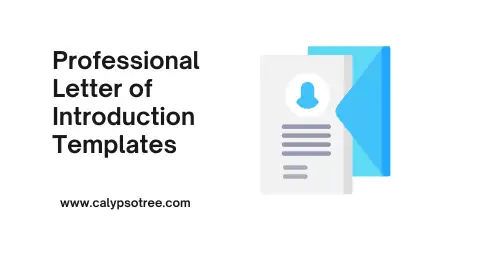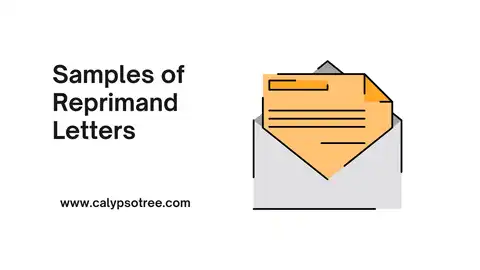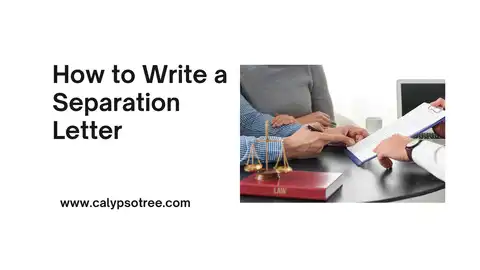Examples of Proof of Employment Letters (Employment Verification Letters) – If you are a boss or an employer, writing proof of employment letters is important. The proof of employment letter is a form that verifies that the employee works in your company. Not only that, but the form also contains information about how much your employees make and other information that a potential creditor requests.
As the employer or the boss, you must pay attention to the possible impact on your employee’s well-being when writing the proof of employment letter template. A mortgage loan, credit card, and college loan can be on the line.
This article will discuss proof of employment letters, the advantages of having, who should write this letter, key information that should be included, proof of employment letters examples, writing tips, and what information should be avoided. Emailing the letters, it the necessary to include salary details and employment verification forms and types.
Advantages of Having Proof of Employment Letters (Employment Verification Letters)
Proof letters about your job are really good for both Employers and Employees. Let’s talk about why these letters are great!
For Employees
- Getting a Loan: If you want to borrow money, this letter says you have a job and can repay it.
- Renting a Place: This letter helps you get a house or apartment because the owner knows you can pay the rent.
- Getting a New Job: Some jobs want to make sure you worked where you said you did. This letter shows you’re telling the truth.
- Travel Plans: If you want to go to another country, some places want to see this letter to know you can care for yourself.
- School or Training: Some places you want to learn might ask for this letter to ensure you’re a good fit.
For Employers
- Being Professional: Giving out these letters makes the company look good and serious about doing things right.
- Staying Safe in Court: This letter can sometimes help with legal problems. It shows who works for the company.
- Happy Employees: Helping employees get what they need makes them like their jobs more.
- Saving Time: A ready letter to fill out makes things quick and easy.
- Right Info: The company gets to say what’s true in the letter, so everything is correct.
Good for Everyone
- Trust: These letters make everyone more sure about what’s going on. That’s good for employers, employees, and even landlords or loan people.
- Being Responsible: Having a real paper that says important things makes everyone do what they should.
So, Proof of Employment Letters are good for a lot of things! They help you get loans and houses and even make everyone at work happier.
Who Can Write a Proof of Employment Letter?
A Proof of Employment Letter is important. People need it for loans, renting places, and school. So, who should write this letter? Let’s find out.
Human Resources (HR)
Most of the time, the Human Resources Department writes the letter. They know everything about your job and pay. People usually believe letters from HR.
Your Direct Manager
In small companies without HR, your manager can write a letter. They know what you do every day. Bigger companies usually like letters from HR more.
Company Leaders
Sometimes, the CEO or a Director writes the letter. It is often for big loans or high job positions. The letter is more powerful when they write it.
The Team That Handles Pay
The Payroll Department knows about your money. They can write a letter when you need to talk about money, like for a loan.
Self-Employed People
If you work for yourself, it’s different. You can show tax forms, contracts, and bills to prove you work. Sometimes, you must get these papers stamped to make them official.
Special Verification Companies
Some businesses use a special service for these letters. These services can look into databases and write a full letter fast. It is good for companies who want to save time.
Knowing who should write your Proof of Employment Letter is key. Pick the person or department that makes the most sense for what you need. It helps the letter do its job without any problems.
What key information should be included?
A proof of employment letter is a paper that says you work somewhere. It helps you get things like loans or a place to live. Here is key information that should be included in a good letter.
For Both Employer and Employee:
- Date: Tells when the letter was made.
- Title: Say the letter is to show someone works somewhere.
- Who Gets It: Put the name and how to reach the person who needs the letter.
From the Employer:
- Place Info: Name and address of the company at the top.
- Signed: Someone like an HR person signs it.
- The job of Signer: Say what job the person who signs has.
About the Employee:
- Full Name: Put the full name of the worker.
- Job: Say what job and part of the company the person is in.
- Start Date: Say when the worker started.
- Work Time: Say if full-time, part-time, or for now.
- Pay: Sometimes, say how much the worker makes.
- What They Do: Sometimes, list the main jobs the worker does.
Other Important Things:
- Why It’s Made: Say why the letter is needed.
- Contact: Add how to talk to the employer for more info.
- End: Use words like “Best wishes,” then the name and job of the signer.
This list helps make sure a work letter is good and useful. It helps both the employer and the employee.
Tips for Writing Proof of Employment Letters (Employment Verification Letters)
Here are some tips to help you create a strong letter.
Start with the Basics
- Use Company Letterhead: Always use official company letterhead to show authenticity.
- Date and Address: Remember to include the date and the recipient’s address, if known.
Include All Required Information
- Employee Details: Clearly state the employee’s full name, job title, and department.
- Employment Status: Indicate whether the employee is full-time, part-time, or temporary.
- Salary: If needed, state the employee’s salary, but make sure this is acceptable to the employee first.
- Date of Hire: Include the date the employee started work.
Be Precise
- Clear Language: Use simple language to avoid any confusion.
- Specifics: Include only the details requested or needed. Only add necessary information that could complicate the letter.
Be Professional
- Spell Check: Proofread the letter for any spelling or grammatical errors. A simple error can make your company look unprofessional.
- Signature: Always have the letter signed by someone in a position of authority, like an HR manager.
Add Extra Details if Needed
- Job Duties: Only include details about job duties or performance if relevant or requested.
- Reason for Issuing: If it needs clarification, add a line stating why the letter is being provided.
Keep Privacy in Mind
- Permission: Ensure you have the employee’s consent to share sensitive information like salary or employment status.
Wrap It Up
- Contact Information: Always provide a way for the letter’s recipient to contact you for further verification.
- Closing and Signature: Use a formal closing and sign the letter.
Bonus: Make Copies
- Documentation: Keep a copy of any Employment Verification Letters you issue. It can protect you in case there are any disputes or questions later.
Following these tips, you can craft an effective and professional Proof of Employment Letter that meets all necessary criteria.
What Information Should Be Avoided?
When you write a Proof of Employment Letter, you should be careful. There are things you should keep in the letter. Let’s learn what to avoid.
Private Information
- Social Security Numbers: Only put this in if you have to. It’s special info.
- Date of Birth: This is also special info. Only add it if needed.
Health Information
- Medical Records: Keep this private. It shouldn’t be in the letter.
- Insurance Details: Don’t talk about any insurance, like health.
How You Do in the Job
- Performance Reviews: This is a company secret. Don’t include it.
- Disciplinary Actions: If you got a warning at work, this should not be in the letter.
Financial Details
- Bank Info: Wait to put bank numbers in the letter.
- Debt or Credit Info: Leave out things like how much money you owe or your credit score.
More Job Details
- Future Plans: Things like promotions or future raises should stay private.
- Reason for Leaving Old Job: This is between you and your old boss. It should not be in the letter.
Personal Thoughts
- Opinions: Don’t put what you think about the person.
- Unverified Info: Only include things that you know are true.
Other Details
- Hobbies: What you like to do for fun doesn’t belong in this letter.
- Marital Status: Whether you’re married or not doesn’t matter here.
Legal Stuff
- Immigration Status: Don’t mention this unless the law says you must.
Remember, keep the letter professional and respect people’s privacy. Only include info that should be there. Make sure your letter is good and proper.
Examples of Proof of Employment Letters
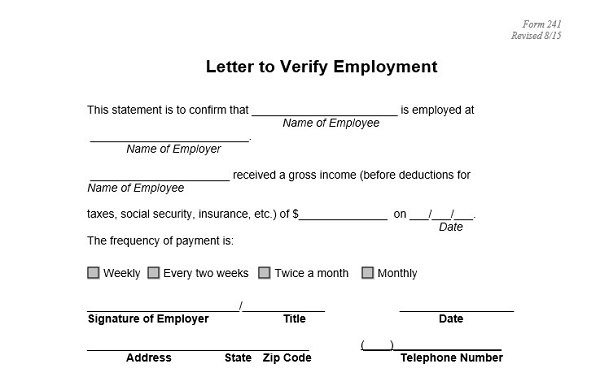
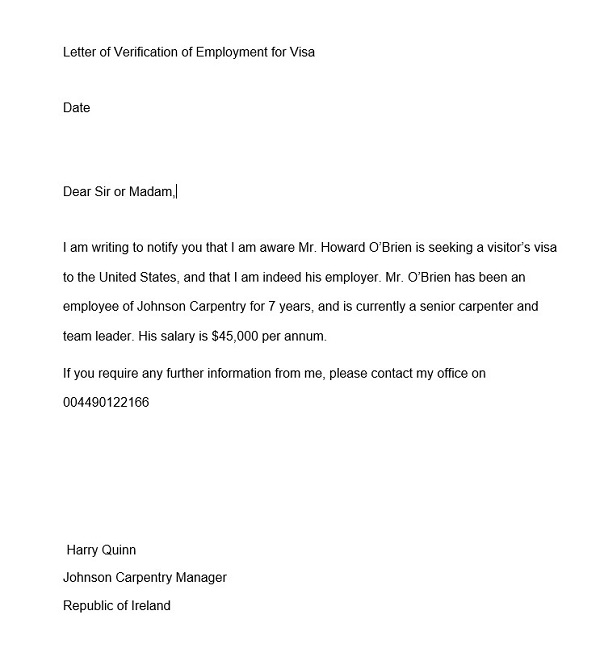
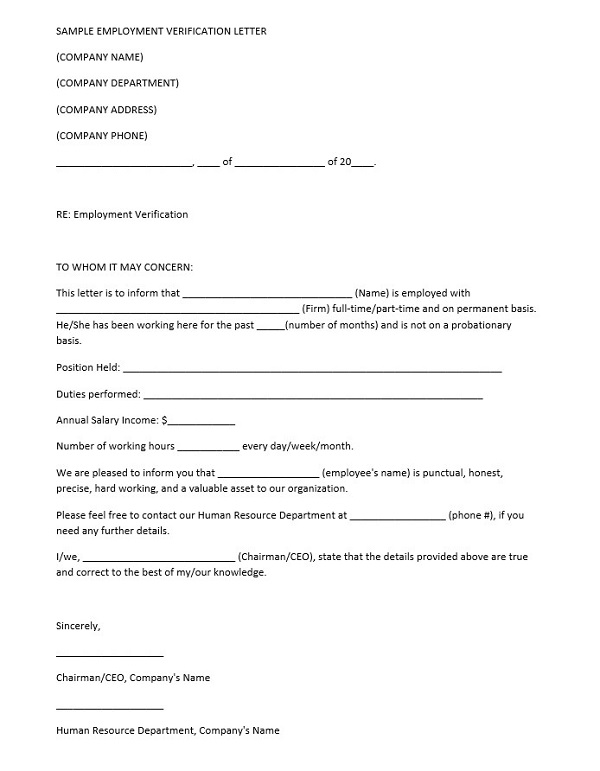
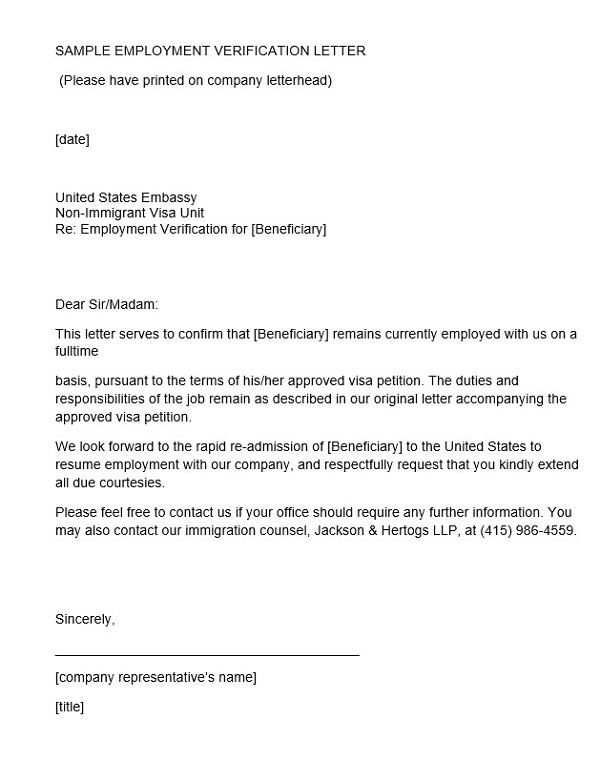
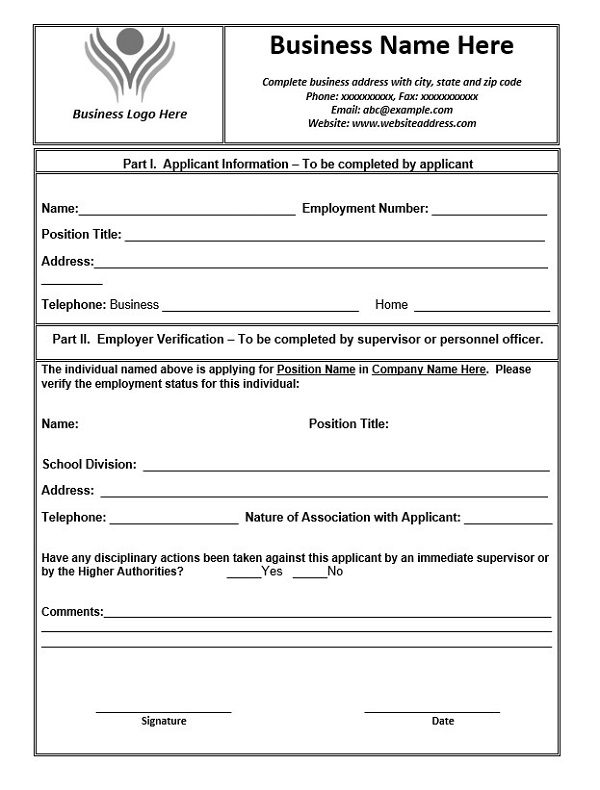
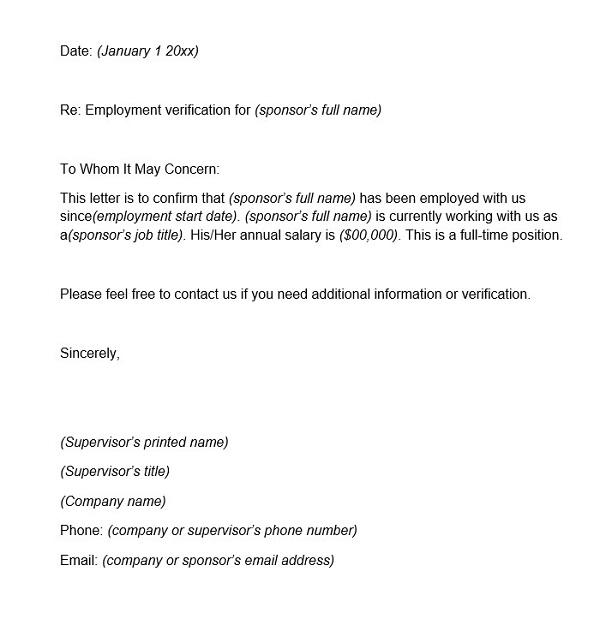
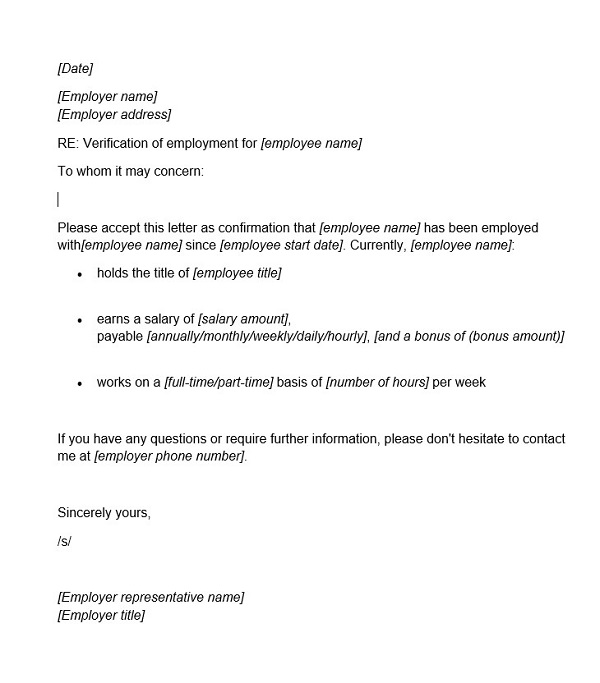
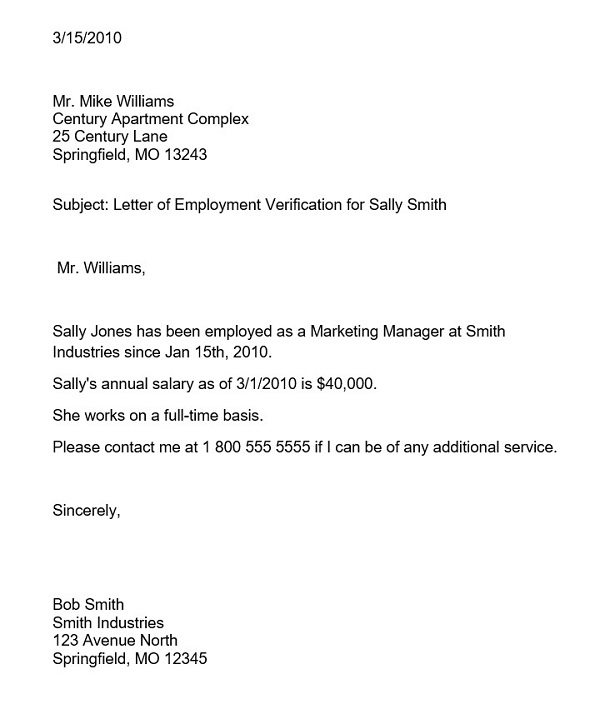
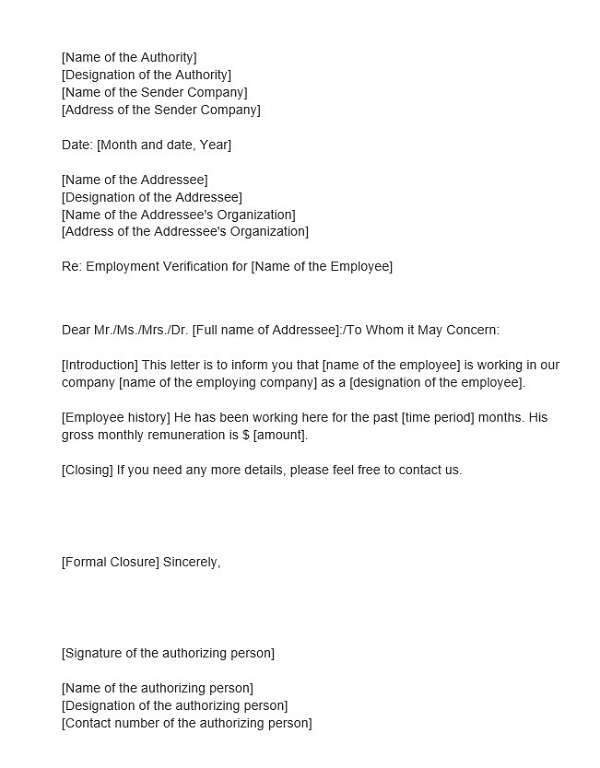
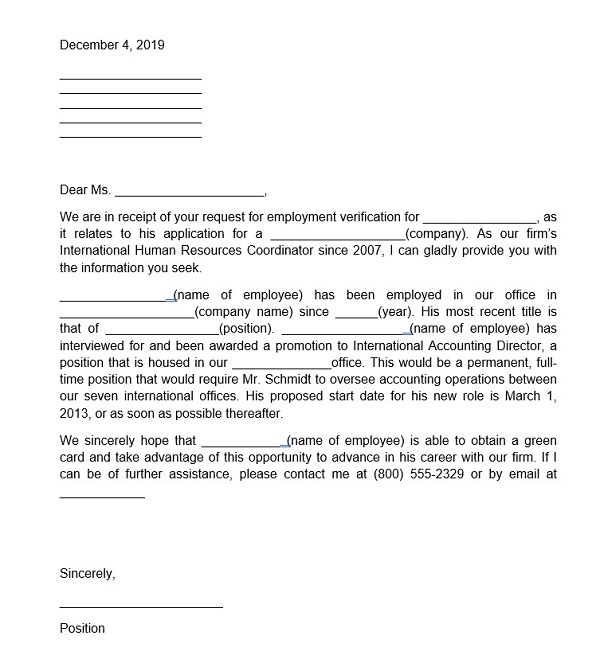
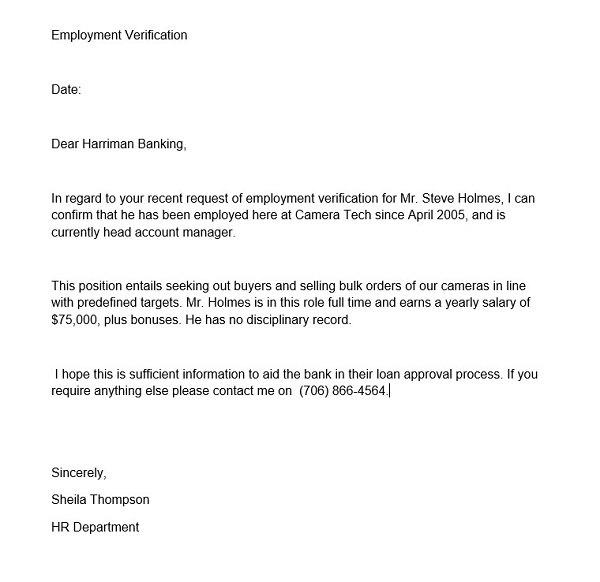
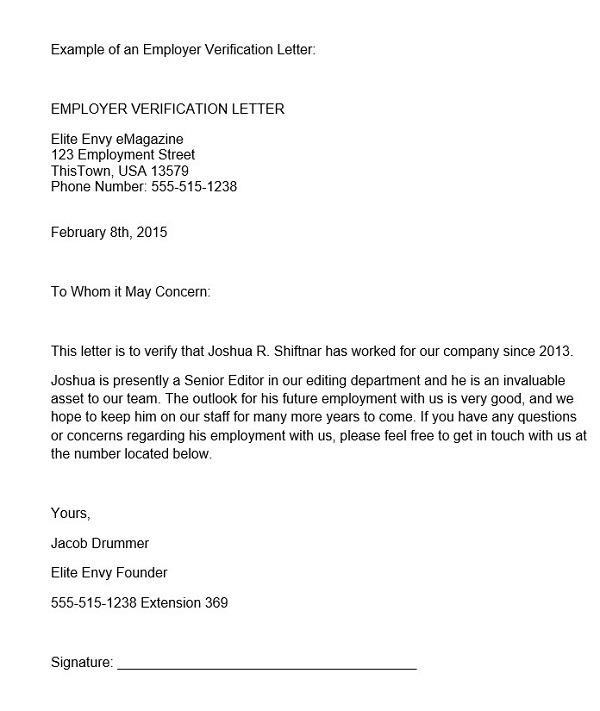
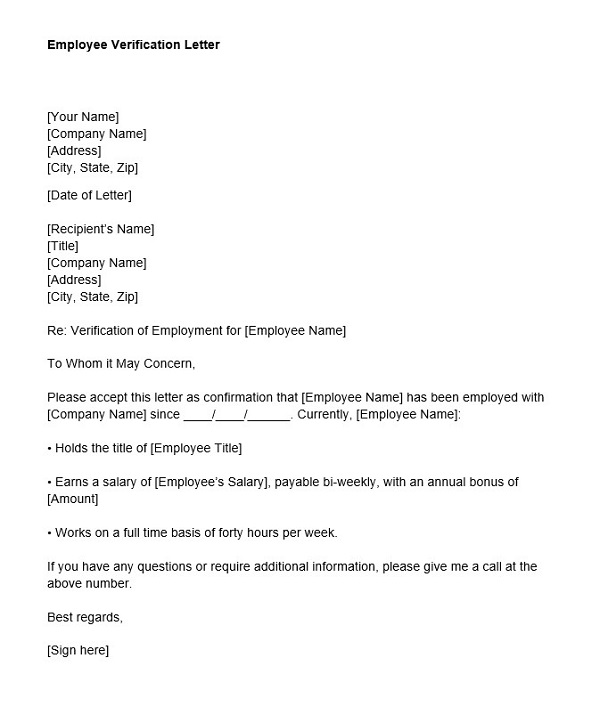
Is Email Acceptable?
In today’s digital age, it’s a common question: Can Proof of Employment Letters be sent via email? The short answer is yes but with some conditions.
When Email is Acceptable
- Time-Sensitive Requests: Email is quicker than regular mail. If the verification is needed urgently, email can be more efficient.
- Follow-Up: After sending an initial hard copy, you can use email as a follow-up for any additional details or clarifications.
- Small Businesses: An email might be okay if you work at a small place.
- International Communication: Email is faster if the letter has to go to another country.
Conditions to Keep in Mind
- Company Policy: Always check your company’s policy regarding this. Some organizations may require formal written letters.
- Recipient Requirements: The entity requesting the verification might have its guidelines, which may require a formal, signed document.
- Security: Make sure your email is secure when sending sensitive information. Use encryption if possible.
- Documentation: Always keep the email you sent. It proves you did what you were asked.
Tips for Emailing Employment Verification Letters
- Subject Line: Make it clear what the email is about. For example, “Proof of Employment for [Employee’s Name].”
- Attachments: Put the letter in the email as a PDF so anyone can open it.
- Signature: Formally say goodbye. Put your name, your job, and how to reach your work.
- Follow-up: Send another email to make sure they got the first one.
So yes, email can work for sending a Proof of Employment Letter. Just remember the rules before you press “send.”
Is it necessary to include salary details in a Proof of Employment Letter?
Including salary details in a Proof of Employment Letter depends on the purpose for which the letter is being used. Here are some points to consider:
Why You Might Include Salary:
- Loan or Credit Application: If the employee needs the letter to apply for a loan, mortgage, or credit card, the lender may want to know their salary to assess their ability to repay.
- Renting a Property: A landlord might request salary details to make sure the tenant can afford the rent.
- Specific Request: If the entity requesting the letter asks for salary information, it should be included.
Why You Might Not Include Salary:
- General Verification: Salary information might not be necessary if the letter confirms that someone works at the company.
- Privacy Concerns: Salary is sensitive information. If not required, it’s often better to leave it out.
- Company Policy: Some companies have strict policies about sharing employee information. Make sure to adhere to these.
So, it’s only sometimes necessary to include salary details in a Proof of Employment Letter. Always consider the reason for the letter and check with the employee and the requesting entity to determine if this information should be included.
Employment Verification Forms & Types
Two Main Kinds of Letters
When you need to prove you have a job, there are two main types of Employment Verification Letters you might use:
- Email Version
- Letterhead Version
Let’s talk about when to use each type and why.
Email Version
What Is It?
An Email Version is a simple letter sent from your work email. It says you have a job and how long you’ve been there. It’s quick and easy.
When to Use It
- Fast Needs: When you need the letter right away.
- Small Companies: Formal letters are optional.
- Follow-Up: After sending a formal one for extra info.
Letterhead Version
What Is It?
The Letterhead Version is very formal. It’s printed on paper with the company logo at the top. Someone like an HR manager signs it.
When to Use It
- Big Choices: Like buying a house or getting a big loan.
- New Job: When another job asks for it.
- Formal Needs: When the company or person asking says it must be this kind.
Email versions are great for quick needs and less formal stuff. Letterhead versions are for when things are very serious and formal.
Conclusion
Examples of Proof of Employment Letters – Those are the explanations of proof of employment letters, advantages of having, who should write this letter, key information that should be included, writing tips, and what information should be avoided. Emailing the letters, it the necessary to include salary details and employment verification forms and types.

The content creator team at calipsotree.com is dedicated to making topics accessible to everyone, with over 9 years of experience in writing and breaking down complex concepts into easy-to-understand articles that answer readers’ financial questions.






